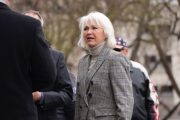
On this day in history, the drafting of the formal Declaration of Independence got underway. After having approved Richard Henry Lee’s resolution calling for declaring independence from Great Britain, the delegates of the Second Continental Congress appointed a committee to draft a formal declaration. This committee is known to history as the Committee of Five.
Before introducing the members of that history-making group, it’s critical to consider the text of the Lee resolution that the members of Congress unanimously passed, the vote giving rise to the calling of the committee tasked with taking the terse resolution and expanding it into something fully expressive of the American attitude and political philosophy. The Lee resolution read:
Resolved, That these United Colonies are, and of right ought to be, free and independent States, that they are absolved from all allegiance to the British Crown, and that all political connection between them and the State of Great Britain is, and ought to be, totally dissolved.
That it is expedient forthwith to take the most effectual measures for forming foreign Alliances.
That a plan of confederation be prepared and transmitted to the respective Colonies for their consideration and approbation.
The committee consisted of John Adams, Benjamin Franklin, Thomas Jefferson, Roger Sherman, and Robert R. Livingston. Their diverse backgrounds and experiences enriched the process of drafting the formal Declaration of Independence.
Thomas Jefferson, the laconic delegate from Virginia, was known to be a gifted writer and philosopher, and thus was entrusted with the task of drafting the Declaration. Furthermore, being from the Old Dominion, arguably the most influential Colony as well as among the most populous, caused Jefferson’s name to percolate to the top of the mind of the delegates gathered there in Philadelphia.
For his part, drawing inspiration from some of the most profound thinkers from the ancient and modern world — Cicero, John Locke, Algernon Sidney — Jefferson meticulously composed a document that elegantly and eloquently proclaimed the principles of natural rights, civil equality, and the right to self-government enjoyed by all mankind as a divine inheritance. The words he penned would resonate throughout history. But not before the other members of that talented and purposefully appointed committee put their particular imprint on Jefferson’s draft of the Declaration. Of his colleagues on the committee, perhaps the most obvious choice was John Adams, a lawyer from Massachusetts.
From the time the gavel banged the Second Continental Congress to order, Adams was known as a staunch advocate for independence. It is no exaggeration to assert that Adams was the driving force behind the formation of the Committee of Five. His fiery rhetoric and unwavering commitment to the cause made him an influential figure, even among the many patriots and other men of renown and reputation serving in the Continental Congress. Adams played a pivotal role in convincing his fellow delegates of the urgency to break away from British rule, setting the stage for the secession of the American Colonies from the British empire. Adams refused to carry on petitioning the powers that be in Britain, begging the crown for recognition of the rights God granted unto all men, specifically unto all Englishmen, regardless of birthplace or time. It is John Adams that lobbied for the appointing of the other men with whom he would bear the burden of penning the proclamation. For Adams, Jefferson was a foregone conclusion for serving on the committee, as was the Nestor of American patriots: Benjamin Franklin.
Benjamin Franklin’s sage wisdom and diplomatic acumen were indispensable during the committee’s deliberations. By 1776, Franklin was known in Europe and America for his sharp intellect and extensive experience. He was an auteur, an inventor, an agitator, and a mediator who was friends with the powerful across Europe. He brought to the table a wealth of knowledge and decades of diplomatic skill. Furthermore, Franklin’s reputation, renown, and record of committed effort to unite the Colonies into a confederation of republics forming an unflinching front against the dismissive and derisive government of Great Britain worked to bridge gaps and foster consensus among the Colonies’ representatives, as well as among the committee members, as designed by Franklin to ensure that the Declaration of Independence reflected the common aspirations of the often conflicting Colonies.
Roger Sherman, a practical and pragmatic statesman, brought a unique perspective to the committee. Hailing from Connecticut, Sherman had a keen understanding of the concerns and interests of the smaller states. His contributions ensured that the language of the Declaration struck a delicate balance, accommodating the diverse needs of the Colonies while maintaining an unqualified opposition to British tyranny.
Like Franklin, Robert R. Livingston was a seasoned diplomat, and he made use of his expertise in the committee’s deliberations. As a representative of New York, Livingston possessed a nuanced understanding of the challenges faced by the Colonies. His diplomatic skills and legal acumen helped shape the language of the Declaration and ensured that it resonated with the sentiments of the Colonists.
When the work of writing and rewriting was over, Thomas Jefferson’s final draft faced rigorous scrutiny and debate within the Continental Congress. Over the course of several days, delegates passionately discussed the wording and content of the document. After passing through several rounds of revision, with some passages amended or omitted, the core principles penned by Jefferson remained intact.
Although principally written by Thomas Jefferson, we must understand that the Declaration of Independence was unquestionably a collective effort, reflecting the diverse perspectives and political compromises necessary to get 13 clocks to strike the hour at the same time.




